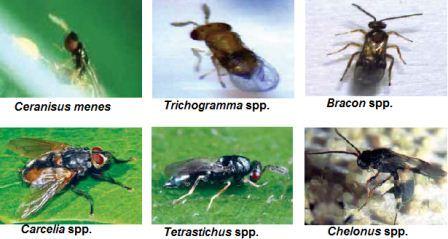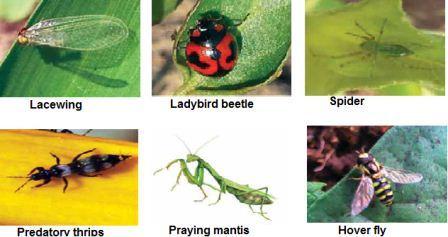Onion:Natural Enemies
Onion:Natural Enemies
Natural Enemies of Onion Insect Pests
Parasitoids

Predators

Flowering plants that attract natural enemies/repel pests
| Natural enemies | Attractant/repellent/trap plants |
| Thrips: | |
| • Parasitoid: Ceranisus menes (nymph) • Predators: Syrphid flies, minute pirate bug/ anthocorid bug (Blaptosthethus sp, Buchananiella whitei, Orius tantilus), praying mantis, predatory thrips (Aeolothrips fasciatum), damsel bug, lace wings, coccinellids (Cheilomenes sexmaculata), spiders etc. |
• Attractant plants: Carrot family, sunflower family, buckwheat, alfalfa, corn, shrubs, marigold, spearmint (ladybug beetle, minute pirate bug & lacewing, syrphid fly, damselfly) • Cosmos (praying mantis) • French bean (predatory thrips) • Sunflower, buckwheat and cowpea (braconid wasp) |
| Maggot: | |
| • Parasitoid: A braconid wasp (Aphaereta pallipes). • Predators: Rove beetle, ground beetle, spiders etc. |
• Interplant strips of ryegrass and cover crops, mulch beds (rove beetle). • Amaranth, white clover, mulching etc (ground beetle). |
| Gram pod borer: | |
| • Parasitoids: Trichogramma chilonis (egg), Tetrastichus spp. (egg), Telenomus spp. (egg), Chelonus blackburni (egg-larval), Carcelia spp. (larval-pupal), Campoletis chlorideae (larval), Goniophthalmus halli (larval), Bracon spp. (larval) etc. • Predators: Chrysoperla zastrowi sillemi, coccinellids, King crow, common mynah, wasp, dragonfly, spider, robber fly, reduviid bug, praying mantis, fi re ants, big eyed bugs (Geocoris sp), pentatomid bug (Eocanthecona furcellata), earwigs, ground beetles, rove beetles etc. • Ovomermis albicans, a nematode |
• Repellant plants: Basil • Attractant plants: Carrot family, sunflower family, buckwheat, alfalfa, corn, shrubs (minute pirate bug & lacewing) • Nectar rich plants with small flowers i.e. anise, caraway, dill, parsley, mustard, sunflower, buckwheat and cowpea (braconid wasp) |
| Tobacco caterpillar: | |
| • Parasitoids: Trichogramma chilonis (egg), Tetrastichus spp. (egg), Telenomus spp. (egg), Chelonus blackburni (egg-larval), Carcelia spp. (larval-pupal), Campoletis chlorideae (larval), Eriborus argenteopilosus (larval), Microplitis sp (larval) etc. • Predators: Chrysoperla zastrowi sillemi, coccinellids, King crow, common mynah, wasp, dragonfly, spider, robber fly, reduviid bug, praying mantis, fire ants, big eyed bugs (Geocoris sp), pentatomid bug (Eocanthecona furcellata), earwigs, ground beetles, rove beetles etc. • Ovomermis albicans, a nematode |
• Repellant plants: Basil • Attractant plants: Carrot family, sunflower family, buckwheat, alfalfa, corn, and shrubs (minute pirate bug and lacewing) • Nectar rich plants with small flowers i.e. anise, caraway, dill, parsley, mustard, sunflower, buckwheat and cowpea (braconid wasp) |
| Mites: | |
| • Predators: Anthocorid bugs (Orius spp.), mirid bugs, syrphid/hover flies, green lacewings (Mallada basalis and Chrysoperla zastrowi sillemi), predatory mites (Amblyseius alstoniae, A. womersleyi, A. fallacies and Phytoseiulus persimilis), predatory coccinellids (Stethorus punctillum), staphylinid beetle (Oligota spp.), predatory cecidomyiid fly (Anthrocnodax occidentalis), predatory gall midge (Feltiella minuta), spiders etc. • Beauveria bassiana (entomo pathogen) |
• Citrus, avocadoes, bananas, papaya, palms, tea, cassava, maize, strawberries, vegetables, and cotton, as well as ornamental plantings, grasslands attract Stethorus punctillum. • Daucus carota (Queen Anne’s lace) attract lady bugs. • Crop rotation: Marigold, Chrysanthemum spp., Sesbania spp., Crotalaria spp., Gaillardia spp., castor and Desmodium spp., (parasitic nematodes) • Border crops: Strips of ryegrass, cover crops and mulch beds (rove beetle). • Carrot family, coriander, bishop’s weed (spider mite destroyer) • Sunflower family, marigold, buckwheat, spearmint (ladybird beetle) • Carrot family, sunflower family, buckwheat, alfalfa, corn, shrubs (minute pirate bug) • Mustard, radish, sweet clove, dill (aphid midge) • French bean (predatory mites) • Berseem clover and sub-terranean clovers (big-eyed bugs) |
IPM for Onion
To know the IPM practices for Onion, click here.
Source: NIPHM and Directorate of Plant Protection, Quarantine & Storage
Last Modified : 2/12/2020
© C–DAC.All content appearing on the vikaspedia portal is through collaborative effort of vikaspedia and its partners.We encourage you to use and share the content in a respectful and fair manner. Please leave all source links intact and adhere to applicable copyright and intellectual property guidelines and laws.
RELATED ITEMS
Apple: Natural Enemies
Natural enemies of apple insect pests are covered ...
Amla Beneficial insects
This topic covers information about Amla Beneficia...
Ber Beneficial Insects
This topic covers information about Ber Beneficial...
Arecanut Beneficial Insects
This topic covers information about Arecanut: Bene...
